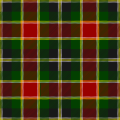
Embroidery is the craft of decorating fabric or other materials using a needle to apply thread or yarn.

A textile is a flexible material consisting of a network of natural or artificial fibers. Yarn is produced by spinning raw fibres of wool, flax, cotton, hemp, or other materials to produce long strands. Textiles are formed by weaving, knitting, crocheting, knotting or tatting, felting, or braiding.

Linen is a textile made from the fibers of the flax plant. Linen is laborious to manufacture, but the fiber is very strong, absorbent and dries faster than cotton. Garments made of linen are valued for their exceptional coolness and freshness in hot and humid weather.
Woven fabric is any textile formed by weaving. Woven fabrics are often created on a loom, and made of many threads woven on a warp and a weft. Technically, a woven fabric is any fabric made by interlacing two or more threads at right angles to one another.
Lawn cloth or lawn is a fine plain weave textile, now chiefly of cotton. Terms also used include batiste and nainsook. Originally the name applied to plain weave linen, and linen lawn is also called "handkerchief linen".
Calendering of textiles is a finishing process used to smooth, coat, or thin a material. With textiles, fabric is passed between calender rollers at high temperatures and pressures. Calendering is used on fabrics such as moire to produce its watered effect and also on cambric and some types of sateens.

Cordura is a collection of fabric technologies used in a wide array of products including luggage, backpacks, trousers, military wear and performance apparel. Cordura fabrics are known for their durability and resistance to abrasions, tears and scuffs.

Textile design is essentially the process of creating designs for woven, knitted or printed fabrics or surface ornamented fabrics. Textile designers are involved with the production of these designs, which are used, sometimes repetitively, in clothing and interior decor items.

Plain weave is the most basic of three fundamental types of textile weaves. It is strong and hard-wearing, and is used for fashion and furnishing fabrics.

Warp knitting is a family of knitting methods in which the yarn zigzags along the length of the fabric; i.e., following adjacent columns, or wales, of knitting, rather than a single row, or course. For comparison, knitting across the width of the fabric is called weft knitting.
A technical textile is a textile product manufactured for non-aesthetic purposes, where function is the primary criterion. Technical textiles include textiles for automotive applications, medical textiles, geotextiles, agrotextiles, and protective clothing.

Textile fibers, threads, yarns and fabrics are measured in a multiplicity of units.
C change is a waterproof and windproof temperature adaptive material developed and produced by Schoeller Textiles.

The conservation and restoration of textiles refers to the processes by which textiles are cared for and maintained to be preserved from future damage. The field falls under the category of art conservation as well as library preservation, depending on the type of collection. In this case, the concept of textile preservation applies to a wide range of artifacts, including tapestries, carpets, quilts, clothing, flags and curtains, as well as objects which ‘’contain’’ textiles, such as upholstered furniture, dolls, and accessories such as fans, parasols, gloves and hats or bonnets. Many of these artifacts require specialized care, often by a professional conservator. The goal of this article is to provide a general overview of the textile preservation process, and to serve as a jumping-off point for further research into more specialized care. Always contact a professional conservator if you are unsure of how to proceed in the preservation process.
Dylon International is a British brand of textile dyes and other household chemicals. It was founded in 1946 by the Mayborn Group. The Mayborn Group sold Dylon International to European homecare company Spotless Group in 2008. Spotless Group was acquired by Henkel in 2014 which is the current owner of Dylon.

Electronic textiles, also known as smart garments, smart clothing, smart textiles, or smart fabrics, are fabrics that enable digital components such as a battery and a light, and electronics to be embedded in them. Smart textiles are fabrics that have been developed with new technologies that provide added value to the wearer. Pailes-Friedman of the Pratt Institute states that "what makes smart fabrics revolutionary is that they have the ability to do many things that traditional fabrics cannot, including communicate, transform, conduct energy and even grow".

Devoré is a fabric technique particularly used on velvets, where a mixed-fibre material undergoes a chemical process to dissolve the cellulose fibers to create a semi-transparent pattern against more solidly woven fabric. The same technique can also be applied to textiles other than velvet, such as lace or the fabrics in burnout t-shirts.
Kotpad Handloom is a vegetable-dyed fabric woven by the tribal weavers of the Mirgan community of Kotpad village in Koraput district, Odisha, India. Cotton sarees with solid border and Pata Anchal, duppatta with typical Buties / motifs, Scolrfs on cotton, silk, handloom stoles, and dress materials are all dyed with organic dyes. The natural dye is manufactured from the aul tree grown in this area. The Kotpad tussar silk saree with tribal art and Kotpad handloom fabrics with natural color is its specialty.
Textile stabilization is a conservation method used to stabilize weak points in textile pieces and prevent further degradation or damage to the fabric.



















